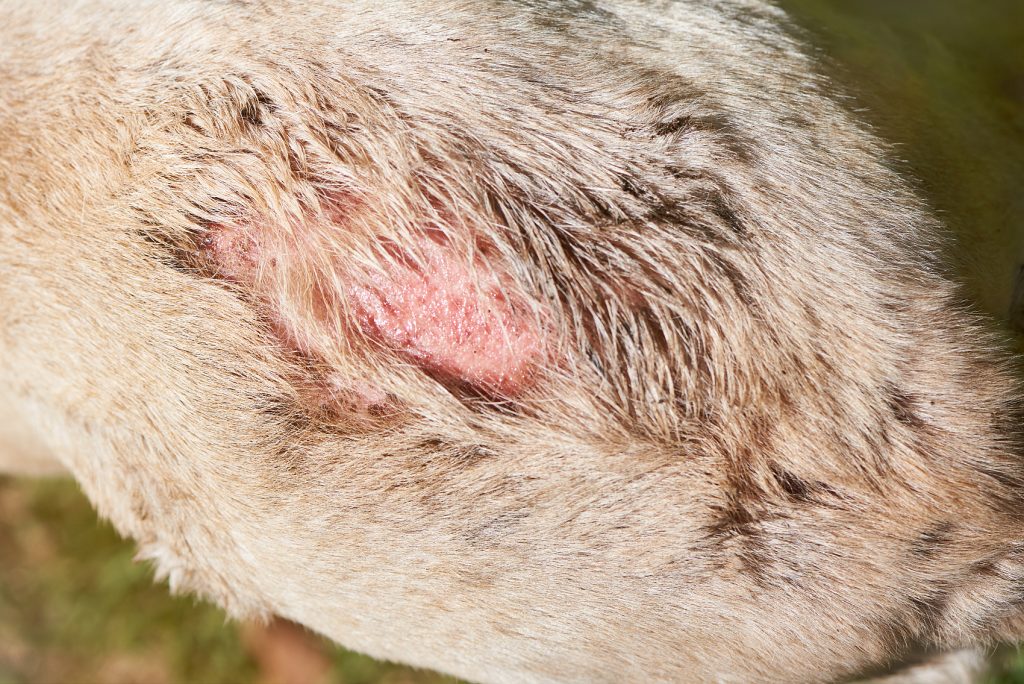Despite its name, ringworm is not a worm—it’s actually a fungal infection caused by Dermatophytes, which are fungi that thrive on the skin. The specific fungus most commonly responsible for ringworm in dogs is Microsporum canis. The name “ringworm” comes from the circular, ring-like lesions it creates, which led people to mistakenly think the condition was caused by worms.
These fungi live on the surface of the skin and inside the skin follicles, feeding on dead skin cells and hair. That’s why maintaining your dog’s skin health is so important.
Symptoms of Ringworm in Dogs
The main sign of ringworm in dogs is a round, hairless patch of skin. While humans often get a clear “ring” shape, dogs don’t always display this. Instead, the lesion will usually grow larger and can become irregular in shape. The infection causes hair shafts to break off, leading to bald spots. The affected skin is often scaly, and while the lesions may or may not itch, the skin is usually red and inflamed.
Ringworm in dogs is most commonly found on the face, ears, tail, and paws.

How Does a Dog Catch Ringworm?
Ringworm is contagious and can spread through direct contact with an infected animal or person. Dogs can catch it from other dogs, cats, or even humans. The fungal spores can linger in the environment for a long time, surviving on carpets, bedding, and grooming tools. Your dog can pick up these spores by coming into contact with contaminated objects or surfaces.
After exposure, it typically takes 10-12 days for lesions to appear.
In rare cases, ringworm can also be spread through infected soil, where the fungus can survive for months under the right conditions. Thankfully, the spores can be killed with a simple bleach and water solution (500 mL of bleach in 4 liters of water).
Can Humans Catch Ringworm from Dogs?
Yes, ringworm is contagious to humans. It can be transmitted by touching an infected dog or cat, especially if there’s direct contact with the animal’s skin or hair. Children are particularly susceptible to catching ringworm from pets.
Are All Dogs Susceptible to Ringworm?
While healthy adult dogs tend to be more resistant to ringworm, puppies are more vulnerable because their immune systems are still developing. Many dogs can carry the fungus without showing any symptoms, but they can still pass it along to other animals or humans.
Diagnosing Ringworm in Dogs
If you suspect your dog has ringworm, your vet will perform a few tests to confirm the diagnosis:
- Wood’s Lamp: This is a black light that can make some types of Microsporum canis glow under ultraviolet light.
- Microscopic Examination: The vet may look at hair or skin samples under a microscope to check for fungal spores.
- Culture: A sample may be sent to a lab to see if the fungus grows, confirming the diagnosis.

Treatment for Ringworm in Dogs
While ringworm can eventually go away on its own in two to four months, it’s best to treat it to reduce discomfort and prevent it from spreading. Treatment options include:
- Banixx: A topical antifungal spray that kills 99% of fungal spores quickly. It’s safe to use around your pet’s eyes and has no harsh odors or burning sensation.
- Griseofulvin: An oral antifungal medication your vet may prescribe. It helps stop the fungus from reproducing, though it can have some side effects.
- Shampoos and Dips: Lime sulfur dips are often recommended. These should be done twice a week, either at the vet’s office or at home. Keep in mind that lime sulfur has a strong smell and can temporarily stain your dog’s fur yellow.
- Decontamination: Thoroughly clean your home by using a bleach solution (1:10 ratio of bleach to water) to kill spores on surfaces. Vacuum daily, dispose of the vacuum bags, and steam clean carpets and furniture. Wash your dog’s bedding and kennel with hot water and bleach.
If your dog is indoors, it’s a good idea to isolate them in one room to prevent the spread of the infection.
Conclusion
Knowing the symptoms and treatment options for ringworm in dogs is key to keeping your pet healthy and preventing the infection from spreading to others. If you notice any signs of ringworm, acting quickly can help reduce the time your dog suffers and limit the risk of contamination. By staying informed, you can ensure your dog’s skin stays clean and protected.












